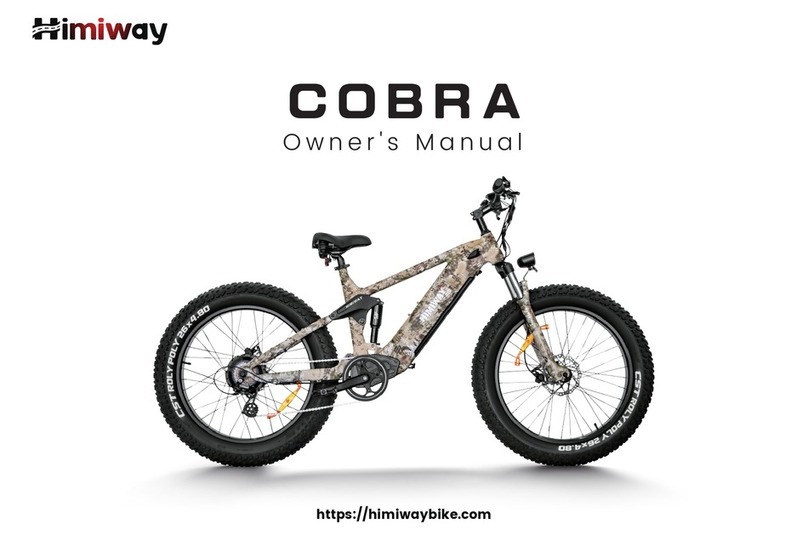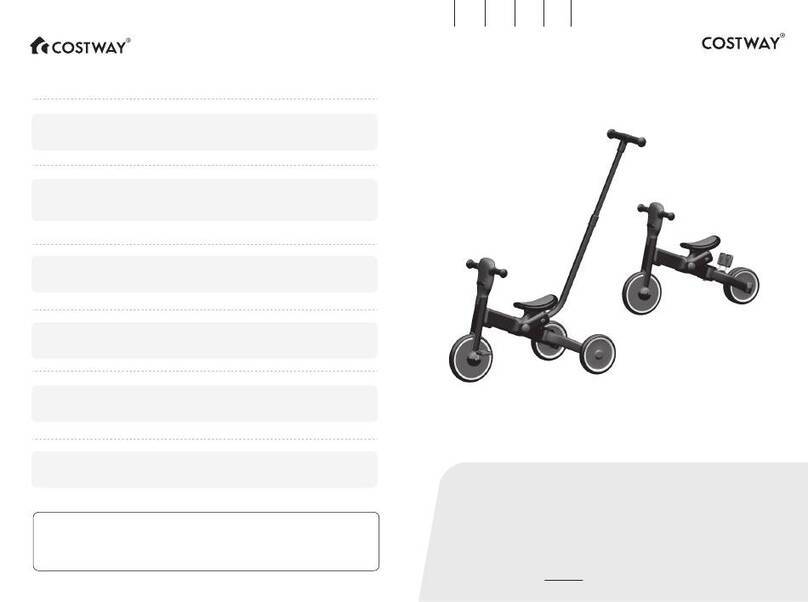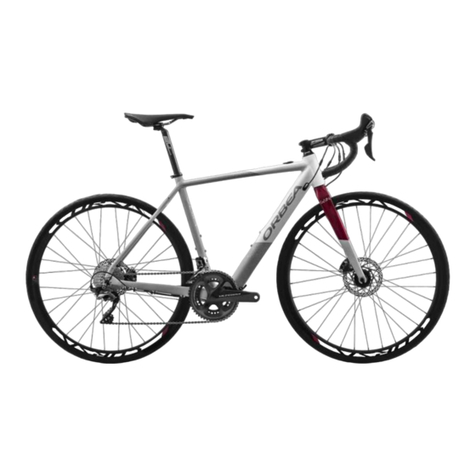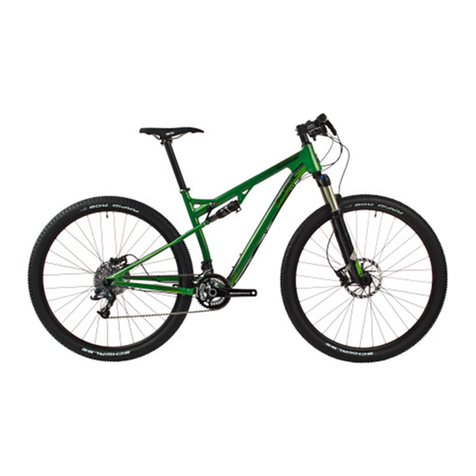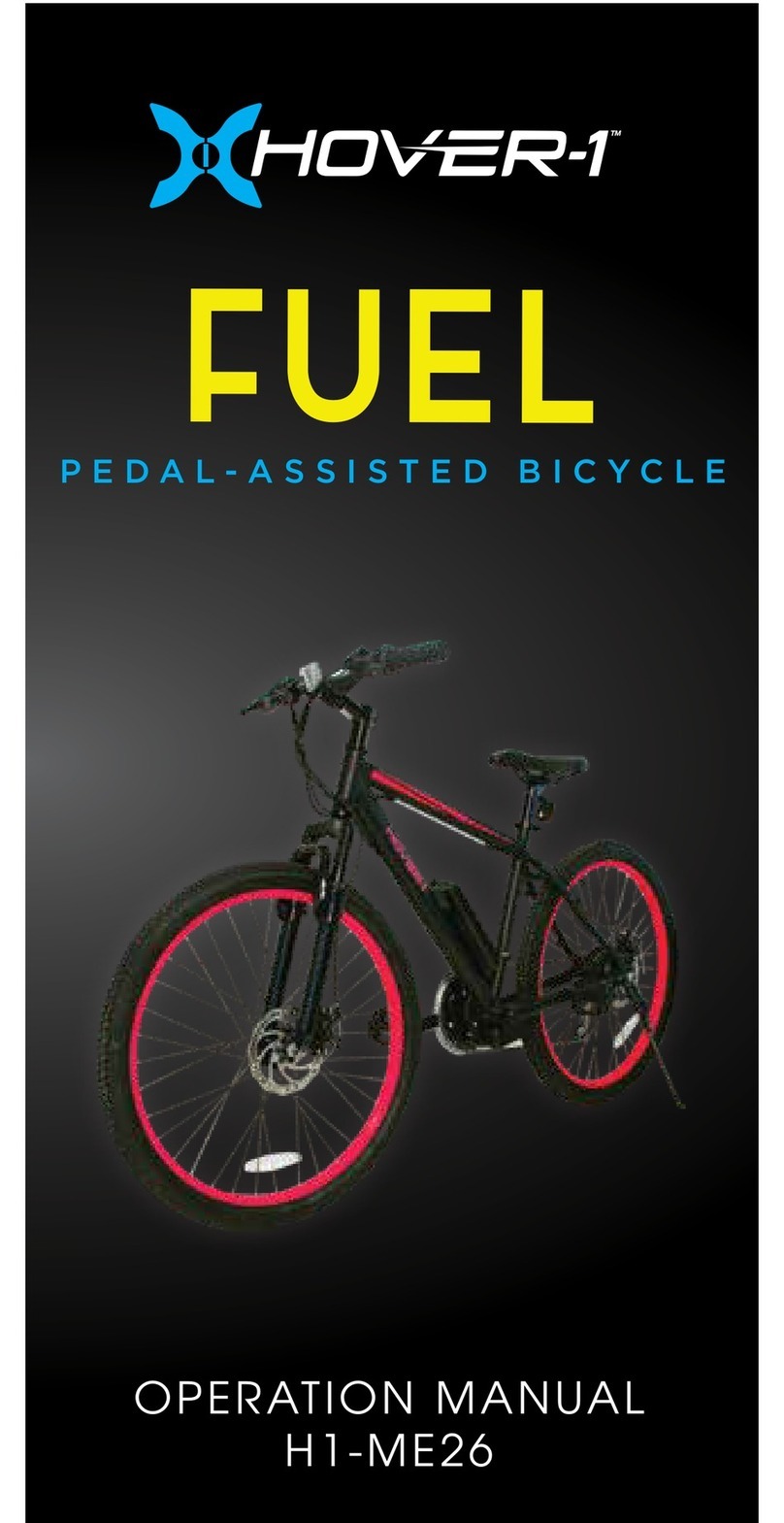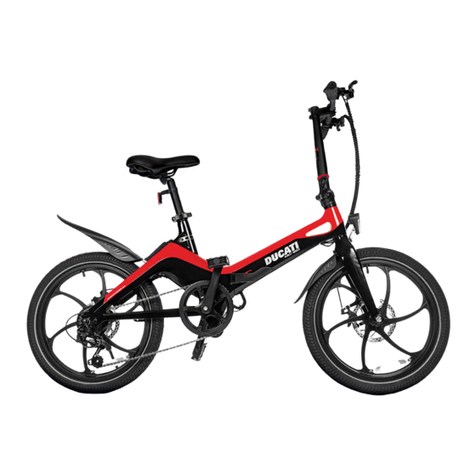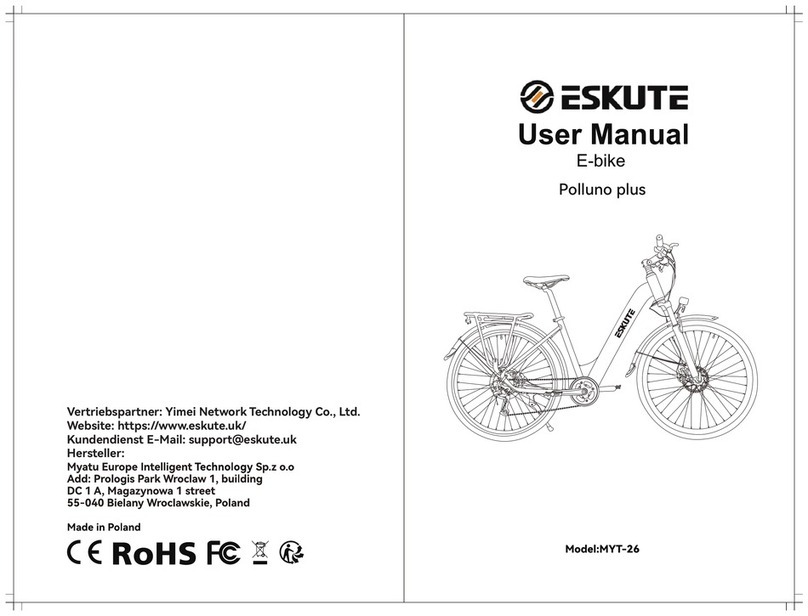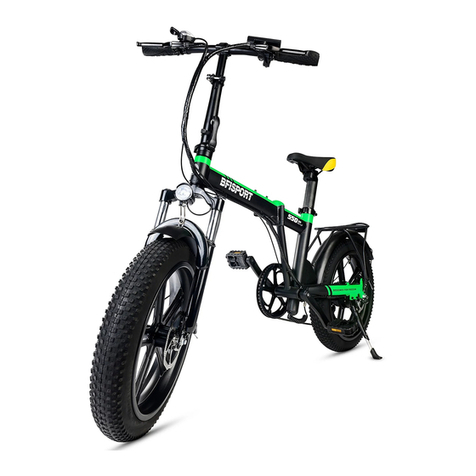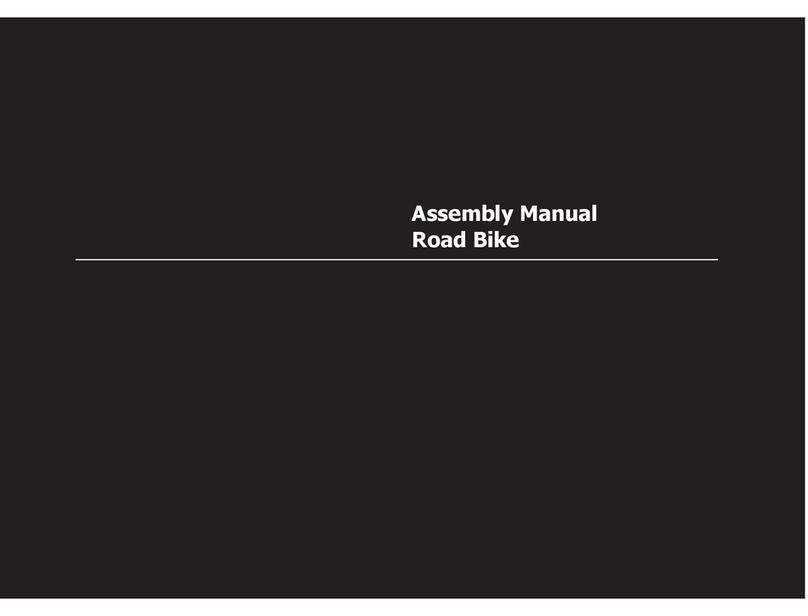Himiway CRUISER User manual

www.himiwaybike.com
Owner's Manual
Cruiser


This manual contains details of the product, and information on its operation and maintenance and other helpful tips for owners. Read it
carefully and familiarize yourself with the Himiway Cruiser before using it to ensure safe use and prevent tragic accidents. Be sure to retain this
manual as your convenient Himiway Cruiser information source.
This manual contains many Warnings and Cautions concerning the safe operation and consequences if safe setup,
operation and maintenance are not performed. All information in this manual should be carefully reviewed and if
you have any questions you should contact Himiway Bike immediately. The notes, warnings and cautions contained
within the manual and marked by this triangular Caution Symbol should also be given special care. Users should
also pay special attention to information marked in this manual beginning with NOTICE.
Because it is impossible to anticipate every situation or condition which can occur while riding, this manual makes no representations about
the safe use of bicycles under all conditions. There are risks associated with the use of any bicycle which cannot be predicted or avoided, and
which are the sole responsibility of the rider. You should keep this manual, along with any other documents that were included with your
bicycle, for future reference, however all content in this manual is subject to change or withdrawal without notice. Visit www.himiwaybike.com
to download the latest version. Himiway Bike makes every effort to ensure accuracy of its documentation and assumes no responsibility of
liability if any errors or inaccuracies appear within. Assembly and first adjustment of your Himiway Bike requires special tools and skills and it is
recommended that this should be done by a trained bicycle mechanic if possible.
About Manual
· 1 ·

Product Specification
Battery
Motor
Display
Derailleur
Speed
Estimate
Pedal Assist
Throttle
Charging Time
Recommended
Rider Heights
48v 17.5Ah Samsung Lithium Battery
750W High Speed Brushless Geared Motor
KDS-KD51C+USB LCD Display
7-speed Shimano-Altus-7 Speed
20 MPH
35~60+ Miles
Intelligent 5 Level Pedal Assist
Half Twist Throttle
6~9 Hours
5.3” ~ 6.4”
Front Fork
Bike Frame
Brake
Charger
Freewheel
Saddle
Shifter
Tires
Product Weight
Total Payload
Capacity
Alloy Front Suspension Fork
26” * 18” AL6061 M Model
Tektro Aries 180mm Brakes
US Standard 2.0A Smart Charger
Shimano 7 Speed
Velo
Shimano-Tourney-ysp
Kenda 26” x 4”
72 Ibs
350 Ibs
· 2 ·

LCD Display Brake
Shimano Shifter
Throttle
On/Off Switch
LED Light Switch
Saddle
Handle
Frame
Rear Brake
Battery
Controller
Pedal
LED Head Light
Front Fork
Front Brake
Tire
Rear Derailleur
Motor
· 3 ·

Safety Checklist
NOTICE: Before every ride it is important to carry out the following safety checks.
Maximum Load Capactiy
350 LBS
28~36.5 INCH
26X4
750W
46.5 inch
45 inch
75 inch
Min / Max Seat Height Total Length
Wheelbase
Handlebar Reach
Tires
Motor
· 4 ·

Safety Check
Brakes
Basic Steps
o Ensure front and rear brakes work properly.
o Ensure brake pads are not over worn and are correctly positioned in relation to the rims.
o Ensure brake control cables are lubricated, correctly adjusted and display no obvious wear.
o Ensure brake control levers are lubricated and tightly secured to the handlebars.
Wheels and Tires
o Ensure tires are inflated to within the recommended limits displayed on the tire sidewalls.
o Ensure ties have tread and have no BULGES OR EXCESSIVE WEAR.
o Ensure rims run true and have no obvious wobbles or kinks.
o Ensure all wheel spokes are tight and not broken.
Steering o Ensure handlebar and stem are correctly adjusted and tightened, and allow proper steering.
o Ensure the handlebar is set correctly in relation to the forks and the direction of travel.
Chain o Ensure the chain is oiled, clean and runs smoothly.
o Extra care is required in wet or dusty conditions.
Cranks and Pedals o Ensure pedals are securely tightened to the cranks.
o Ensure the cranks are securely tightened and are not bent.
Derailleurs
o Check that the derailleur(s) are adjusted and functioning properly.
o Ensure shift and brake levers are attached to the handlebar securely.
o Ensure all brake and shift cables are properly lubricated.
Motor Drive Assembly and Throttle
o Ensure hub motor is spinning smoothly and the motor bearings are in good working order.
o Ensure all power cables running to hub motor are secured and undamaged.
o Make sure the hub motor axle bolts are secured and all torque arms and torque washers are
in place.
Battery Pack
o Ensure battery is charged before use.
o Ensure there is no damage to battery pack.
o Lock battery to frame and check to see that it is secured.
· 5 ·

NOTICE: The following assembly steps are only a general guide to assist in the assembly of your Himiway Bike and is not a
complete or comprehensive manual of all aspects of assembly, maintenance and repair. We recommend you consult a certified
bicycle mechanic to assist in the assembly, repair and maintenance of your bicycle. For detailed instructions please view the
Himiway Cruiser Assembly video and Quick Release Installation video found at www.himiwaybike.com.
Step 1 : Install the handle bars. Remove the four screws from the stem, ensuring the linear markings on the handlebars are centered and
handlebars are adjusted to the comfortable position. Finally, tighten the screws with the assembly tool.
Step 2 : Install the headlight. Use a socket wrench to hold the nut and loosen the screw with a screwdriver and remove the screw. Install the
screw pass through headlight and the bracket and adjust the headlight properly for riding conditions.
Step 3 : Install the front wheel. Remove the plastic axle guards from the front wheel being sure not to touch the brake rotor set. Open the
quick skewer and remove the thumb nut and cone spring. Carefully lower the fork and ensure the brake rotor goes into the caliper.
Next align the dropouts with the axle of the wheel hub to make sure the fork dropouts are fully seated on the axle. Install the quick
skewer starting from the brake rotor side of the wheel and then push quick release skewer through the hub. Keep two cone springs
pointed towards the wheel hub. Tighten the thumb nut until the quick release lever is held in line with the axle, and then use your palm
of your hand to close the quick release skewer.
Assembly Instructions
· 6 ·

Step 4 : Use a bike pump with a press gauge to Inflate tires to desired PSI. The recommended pressure for this mode is 20 PSI (1.379 Bar). Do
not overinflate or underinflate tires.
Step 5 : Install the pedals. The left and right pedals are marked on both ends. First, install the right pedal by tightening the pedal in clockwise
direction. The left pedal is tightened by turning the pedal in counterclockwise direction. Both pedals should be tightened to 35 Newton
meters by using a torque wrench.
Step 6 : Adjust the saddle height. loosen the seat clamp, remove the seat post and ensure the seat clamp is centered over the hole in the seat
tube. Insert the seat post into the slot, adjust the saddle height to a suitable height and tighten the adjustment nut. When you feel
resistance, close the seat tube clamp fully.
Step 7 : Adjust the seat position forwards or backwards. Use a allen wrench to loosen the seat adjustment bolt and make sure to stay within
the marked adjustment range.
Step 8 : Install the optional rear rack. Align the holes in the rear rack with the holes in the frame and tighten with screws.
Step 9 : Check the battery pack is locked into the frame of the Himiway Cruiser. When you want to take off the battery, insert the key and
turn to release the battery pack. The battery pack can be removed and charged separately. This is the charging port. Align the
battery pack to the battery holder carefully and push until when you hear it click into the place.
· 7 ·

Torque Required (Nm)
18-20
18-20
18-20
16-25
35-40
35-55
35
6
10
40
6
7
7
Hardware Location
Handlebar
Stem
Saddle
Front Wheel (For Bikes with Bolt on Front Wheel)
Rear Wheel
Bottom Bracket Parts
Pedals
Disk Mounting Bolts
Disk Caliper Mount
Crank Bolts
Rear Derailleur Cable Pinch
Front Derailleur Clamp
Saddle Post Clamp
Recommended Torque Values
NOTICE: Ensure all hardware is tightened properly and all safety checks in the following sections are performed before first use.
Contact Himiway Bike if you have any questions regarding the assembly of your bike. If you are not able to ensure all the assembly
steps in the assembly video are performed properly, or you are unable to view the assembly video please consult a certified local
bicycle service provider for assistance in addition to contacting Himiway Bike for help.
· 8 ·

After the bike has been properly assembled following the unboxing video and all components are secured correctly, you may now proceed to
start up the vehicle and select the power level following the next steps.
1. Hold down the centre mode button on the display remote for 2 seconds then release, the display should turn on.
2. Select your desired level of pedal assistance between level 0 through 5 using the up and down arrows on the display remote. Level 1
corresponds to the lowest level of pedal assistance, and level 5 corresponds to the highest level of pedal assistance. Level 0 indicates
pedal assistance will be inactive.
3. To turn on the headlight once the LCD display are on, hold down the top and middle button located on the left side of the handlebars for
2-3 seconds.
4. With the proper safety gear and rider knowledge and understanding you may now proceed to operate your Himiway Bike. You can begin
by pedaling the bike in the appropriate drivetrain gear with or without pedal assistance. You may also use the throttle to accelerate and
maintain your desired speed.
The image shows the various features and information displayed on the Display.
Start-Up Procedure
Display Features
Push-assistance Level Indication Area
Speed Indication
Speed Unit
Range / Time Unit
Text Indication
Function List
The Lighting Indicator
Power Indicator
Battery Indicator Power Output Indication
· 9 ·

ԵPower ON/OFF
After pressing the power button for seconds, the meter starts to work and provides the working power of the controller. In the power-on
mode, press and hold the power button to turn off the electric bikes power supply. In the off mode, the meter no longer uses the battery's
powersupply, and the meter's leakage current is less than 1uA.
If the electric bike is not used for more than 10 minutes, the meter will automatically shut down.
ԵDisplay Interface
When the meter is turned on, the meter displays the real-time speed and total mileage (km) by default. Short press the “i” button to display
the information in real time speed (km/h), average speed (km/h), maximum speed (km/h), single mileage (km), total mileage (km) .
Routine Operation
· 10 ·

ԵHelp Push
Press and hold the “—” button to hold it down. After 2 seconds, the electric bike enters the power assist mode. The electric bike travels at a
constant speed of 6 kilometers per hour. At the same time, the screen displays “WALK”. Release the “—” button and the electric bike will
immediately stop the power output and return to the state before the boost.
The power-saving function can only be used when the user pushes the electric
bike. Do not use it while riding.
ԵTurn ON/OFF the Backlight
Press and hold the “ ” button for 2 seconds, the instrument backlight is turned on, and the controller is
notified to turn on the headlights. When the external light is insufficient or driving at night, the LCD backlight
can be turned on. Press and hold the “ ”button again for 2 seconds to turn off the LCD backlight and notify
the controller turns off the headlights.
ԵHelp Gear Selection
Press the “+” or “—” button to switch the power assist position of the electric vehicle and change the output
power of the motor. The default output power range of the meter is 0-5, the 0 position is the stop power
output, the 1st gear is the lowest power, and the 5th gear is the highest power. When the 5th gear is reached,
press the “+” button again, the interface will still display 5, and the 5 flashings will indicate that it is the
highest. After the assisted downshift reaches 0, press the “—” button again, the interface will still display 0,
and flash with 0 to indicate that the current is the lowest. The default gear position for the instrument is 1 file.
· 11 ·

ԵBattery Capacity Display
The display on the handlebar of your Himiway Bike features a battery capacity gauge (much like the fuel gauge on an automobile). It is
recommended that users charge the bike as soon as possible once one bar is left on the display. Once the battery is fully depleted, the last
remaining bar will begin to flash, communicating to the user that they should cease operation immediately.
ԵMotor Power Indication
The motor output power can be known through the meter. The display mode is as shown below.
ԵError Detection Display
Your Himiway Bike is equipped with an error detection system integrated into the display and controller. In the
case of an electronic control system fault an error code should display. The following error codes are the most
common and can aid in troubleshooting.
· 12 ·

When the error code is displayed, please promptly remove the fault. After the fault occurs, the electric bike will not be able to ride normally.
Error Code
21
22
23
Definition
Abnormal Current
Throttle Fault
Motor Phase Problem
Error Code
24
25
30
Definition
Motor Hall Defect
Brake Failed or Brake Applied While Turning On
Abnormal Communication
Press and hold the power button to turn it on. In the power-on state, while the vehicle is stationary, press and hold the “+” and “—” buttons
simultaneously for more than 2 seconds, and the meter enters the normal setting state.
Each setting item needs to be carried out while the e-bike is stationary.
ԵSingle Mileage Clear
TC stands for clearing a single mileage. Y/N can be selected by pressing the “+” or “—” button, and Y means
clearing the single riding mileage. N means that the single riding distance is not cleared. Short press the “i”
button to confirm and enter the backlight brightness setting state.
ԵBacklight Brightness
The single mileage clear operation interface bL represents the backlight. Parameters 1, 2, and 3 can be set to
indicate backlight brightness, 1 is the darkest, 2 is the standard brightness, and 3 is the brightest. The factory
default value is 1. Press the “+” or “—” button to change the backlight brightness parameter. Short press the “i”
button to confirm and enter the metric unit conversion setting state. Press and hold the “i” button to confirm
and exit the general setting state.
General Settings
· 13 ·

ԵInch and Metric Conversion
U stands for unit, 1 stands for imperial system, and 2 stands for metric system. The speed
and mileage units can be converted by the “+” or “—” buttons. Press the “i” button to
confirm. Press and hold the “i” button to confirm and exit the normal setting. The default
unit of the meter is metric.
Press and hold the “+” and “—” buttons simultaneously for more than 2 seconds to enter the normal setting state. Press and hold the “—” and
“i” buttons simultaneously for more than 2 seconds to enter the wheel diameter setting interface.
ԵWheel Diameter Setting
LD stands for wheel diameter and can be set to 16, 18, 20, 22, 24, 26, 700C, 28. Use the “+” or “—” buttons to
select the wheel diameter corresponding to the e-bike to ensure the accuracy of the meter speed display and
mileage display. The factory default wheel diameter value is 26inch. Short press the “i” button to enter the speed
limit setting interface.
ԵSpeed Limit Setting
Wheel diameter setting interface
The default value of the highest riding speed of the instrument is 25 km/h. Change this value to set the maximum
riding speed of the electric vehicle. When the electric motor exceeds the set value, the controller will stop
supplying power to the motor to protect the rider.
Driving safety: LS means speed limit, the maximum speed setting value can be selected from 12 km/h to 40 km/h,
can be adjusted by + or “-” button; press “i” button confirm and exit the setup status.
General Parameter Settings
· 14 ·

The range of your Himiway Bike is the distance the bike will travel on a single full charge of the onboard battery pack. The range values in this
manual are estimates based on expected usage characteristics. Some of the factors which effect range include changes in elevation, speed,
payload, and acceleration, number of starts and stops and ambient air temperatures. Tire pressure and terrain are also important variables to
consider.
We suggest that you select a lower assistance level when you first get your Himiway Bike to get to know your bike and travel routes. Once you
become familiar with the range requirements of your travel routes, and the capabilities of your Himiway Bike you can then adjust you riding
characteristics if you so desire.
The following table provides general estimates and outlines various factors effecting range and their combined estimated effects on range.
This table is meant to help owners understand the factors that can increase of decrease range, but Himiway Bike makes no claims to the range
that individual users might obtain.
Ե'RQRWFOLPEKLOOVVWHHSHUWKDQLQJUDGH
Ե3HGDOWRDVVLVWWKHPRWRUZKHQFOLPELQJKLOOVDQGDFFHOHUDWLQJIURPDVWRS
Ե$YRLGVXGGHQVWDUWVDQGVWRSV
Ե$FFHOHUDWHVORZO\
Best Practices for Extending Range and Battery Life
Driving Range
· 15 ·

Please follow these basic parking, storage and transport tips to ensure your bike is well cared for on and off the road.
Ե:KHQSXVKLQJWKHYHKLFOHPDQXDOO\WXUQRIIWKHSRZHUWRDYRLGDFFLGHQWDODFFHOHUDWLRQIURPWKHPRWRU
Ե,WLVUHFRPPHQGHGWRSDUNLQGRRUV
Ե6ZLWFKWKHSRZHURIIDQGDQ\OLJKWVWRFRQVHUYHEDWWHU\5HPRYHWKHNH\IURPWKHELNHDQGHQVXUHWKHEDWWHU\LVORFNHGWRWKHIUDPHRU
removed and brought with you for security.
Ե,QSXEOLFSODFHV\RXU+LPLZD\%LNHPXVWEHSDUNHGLQDFFRUGDQFHZLWKORFDOUXOHVDQGUHJXODWLRQV
Ե,I\RXPXVWSDUNRXWGRRUVLQUDLQRUZHWFRQGLWLRQV\RXVKRXOGRQO\OHDYH\RXU+LPLZD\%LNHRXWVLGHIRUDIHZKRXUVDQGSURFHHGWRSDUN
the bike in a dry location afterwards to allow all the systems to dry out. Much like a regular bike, use in wet conditions mandates a more
regular maintenance schedule to ensure your bike does not become rusty, corroded and to ensure all systems are always working safely.
Ե'RQRWSDUNVWRUHRUWUDQVSRUW\RXU+LPLZD\%LNHRQDUDFNWKDWLVQRWGHVLJQHGIRUWKHVL]HDQGZHLJKWRIWKHELNH
Ե:LGHWLUHVDVXVHGRQ+LPLZD\%LNHFDQQRWILWLQWRDOOELNHUDFNVSOHDVHVHOHFWDQDSSURSULDWHUDFNIRUWKHZLGWKRIWLUHVXVHGRQ\RXUELNH
Ե/RFNLQJXS\RXUELNHLVUHFRPPHQGHGWRHQVXUH\RXUELNHLVVHFXUHDQGWKHFKDQFHRIWKHIWLVUHGXFHG+LPLZD\%LNHPDNHVQRFODLPVRU
recommendations on the proper lock hardware or procedures to secure your bike, but we do recommend you take the appropriate
precautions to keep your Himiway Bike safe from theft.
Ե:KHQVWRULQJ\RXUELNHRUFDUU\LQJ\RXUELNHRQDUDFNIRUWUDQVSRUW\RXFDQUHPRYHWKHEDWWHU\SDFNWRUHGXFHWKHZHLJKWRIWKHELNH
and make lifting and loading easier.
Parking Storage and Transport
NOTICE: It is recommended that users pay close attention and ride within the following limitations to ensure the hub motor does not
overheat or become damaged from excessive loading.
· 16 ·

MAXIMUM PAYLOAD FOR Himiway Cruiser
The total maximum weight limit of the Himiway Cruiser(125 Kilograms) includes the weight of the rider as well as clothing, riding gear, cargo,
etc. The kickstand is not designed to be used for loading cargo. You MUST hold onto the bike whenever loading cargo. Do not assume the
bike is stable and balanced when using the kickstand, always hold onto the bike when cargo is being loaded or in place.
Total maximum payload: 125 Kilograms.
Carrying a cargo load involves additional risks which need to be paid close attention to, users should practice riding on a flat and open area
with light cargo before attempting to carry heavier loads. You must become accustomed to the braking, steering, and operational adjustments
required to safely operate the Himiway Cruiser with cargo. Braking, acceleration, and balancing are all significantly affected by the addition of
cargo loaded on the Himiway Cruiser.
The following bulleted list provides important tips for the safe operation of the Himiway Cruiser when used for carrying cargo.
• Plan your route accordingly as your hill climbing ability, steering and braking are all impacted when cargo is loaded on the Himiway Cruiser.
Hills that are normally easy to climb and descend without cargo can become challenging and dangerous once cargo is loaded.
• Cargo should be loaded as low as possible to lower the center of gravity and improve stability, but ensure that cargo does not interfere
with any moving components or the ground.
• Ensure your loads are properly secured and periodically check that nothing loosens.
• Get a feel for the cargo load in a flat and open area before riding on roads.
Carrying Loads
Carrying Cargo
· 17 ·

Follow these steps for charging your Himiway Bike:
1. Turn the battery pack off using the key switch.
2. Remove the rubber cover on the charging socket on the opposite side of the battery switch.
3 .With the battery on or off the bike, place the charger in a flat, secure place, and connect the DC output plug from the charger (round
barrel connector) to the charging port on the side of the battery pack.
Charging Procedure
Do not use the front brake by itself, always apply the rear brake first followed by the front brake and be sure to
use both brakes for all braking operations. Front fork failure or loss of control are plausible when the front brake
is operated independently for slowing at high speed with cargo loads.
The kickstand is not designed to be used for loading cargo. You MUST hold onto the bike whenever loading
cargo. Do not assume the bike is stable and balanced when using the kickstand, always hold onto the bike
when cargo is being loaded or in place.
· 18 ·
Other manuals for CRUISER
1
Table of contents
Other Himiway Bicycle manuals
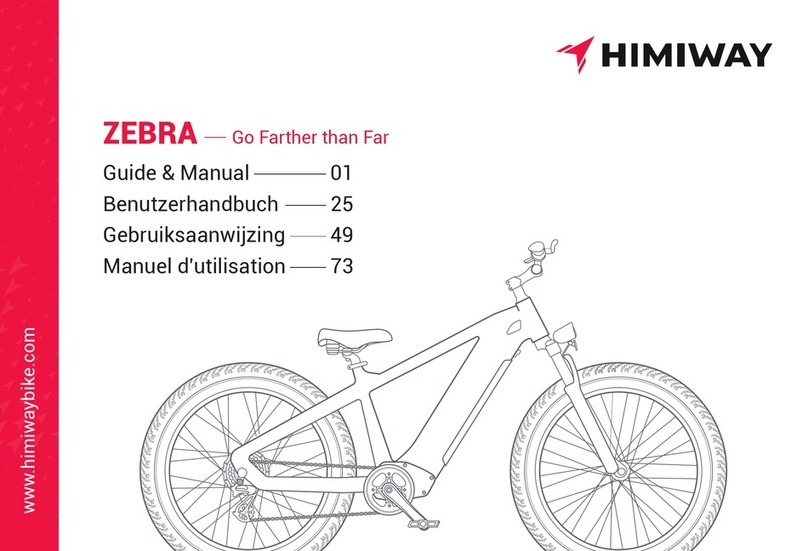
Himiway
Himiway ZEBRA User manual
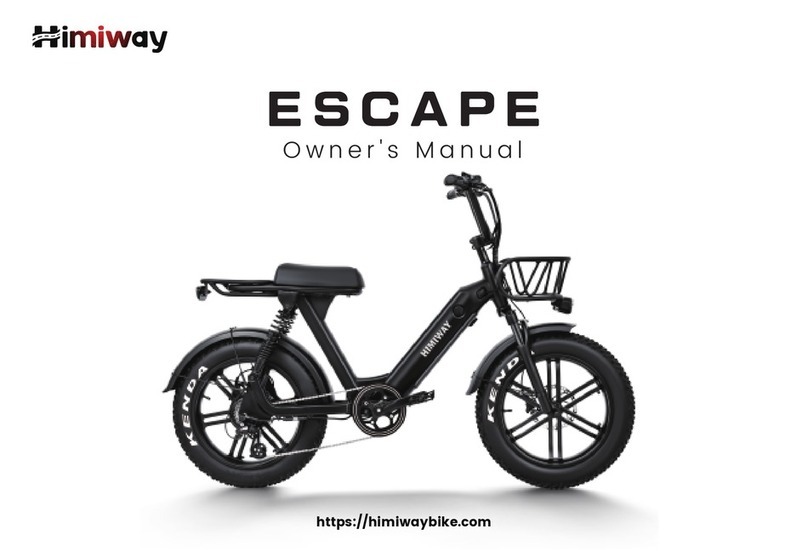
Himiway
Himiway ESCAPE User manual

Himiway
Himiway COBRA User manual

Himiway
Himiway COBRA PRO User manual

Himiway
Himiway BIG DOG User manual
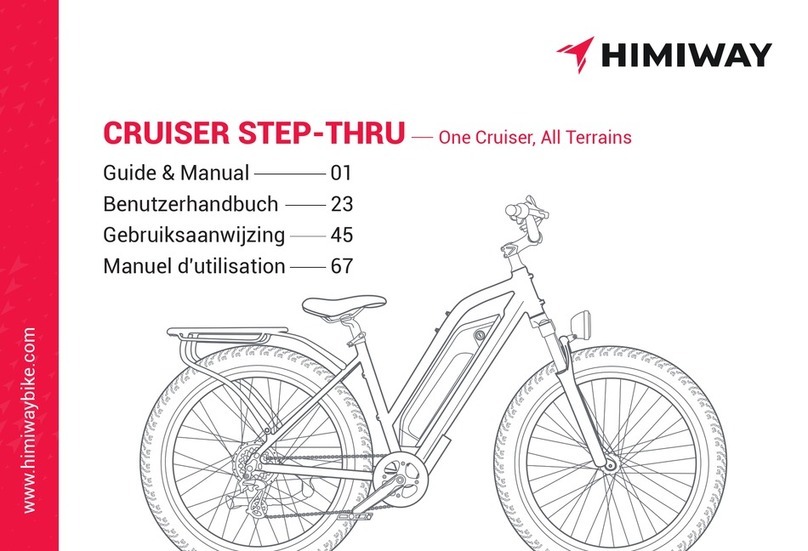
Himiway
Himiway CRUISER STEP-THRU User manual

Himiway
Himiway BIG DOG User manual
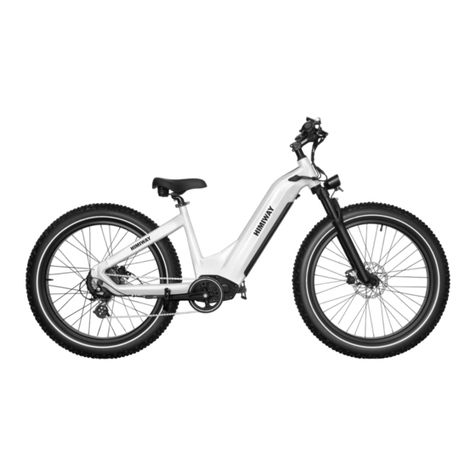
Himiway
Himiway ZEBRA STEP-THRU User manual

Himiway
Himiway ESCAPE User manual

Himiway
Himiway CRUISER User manual
